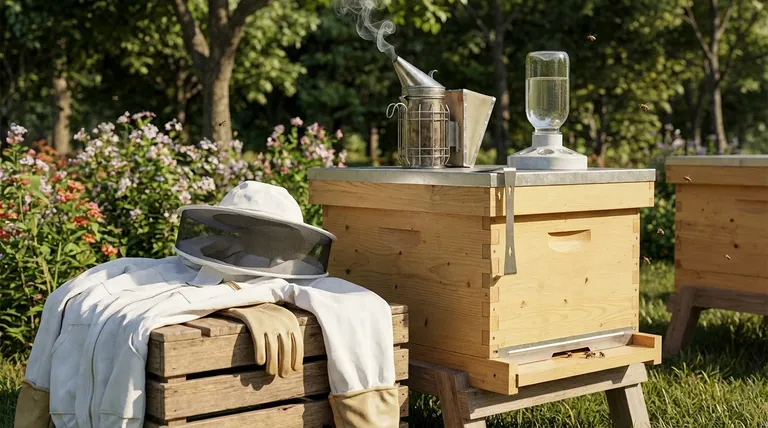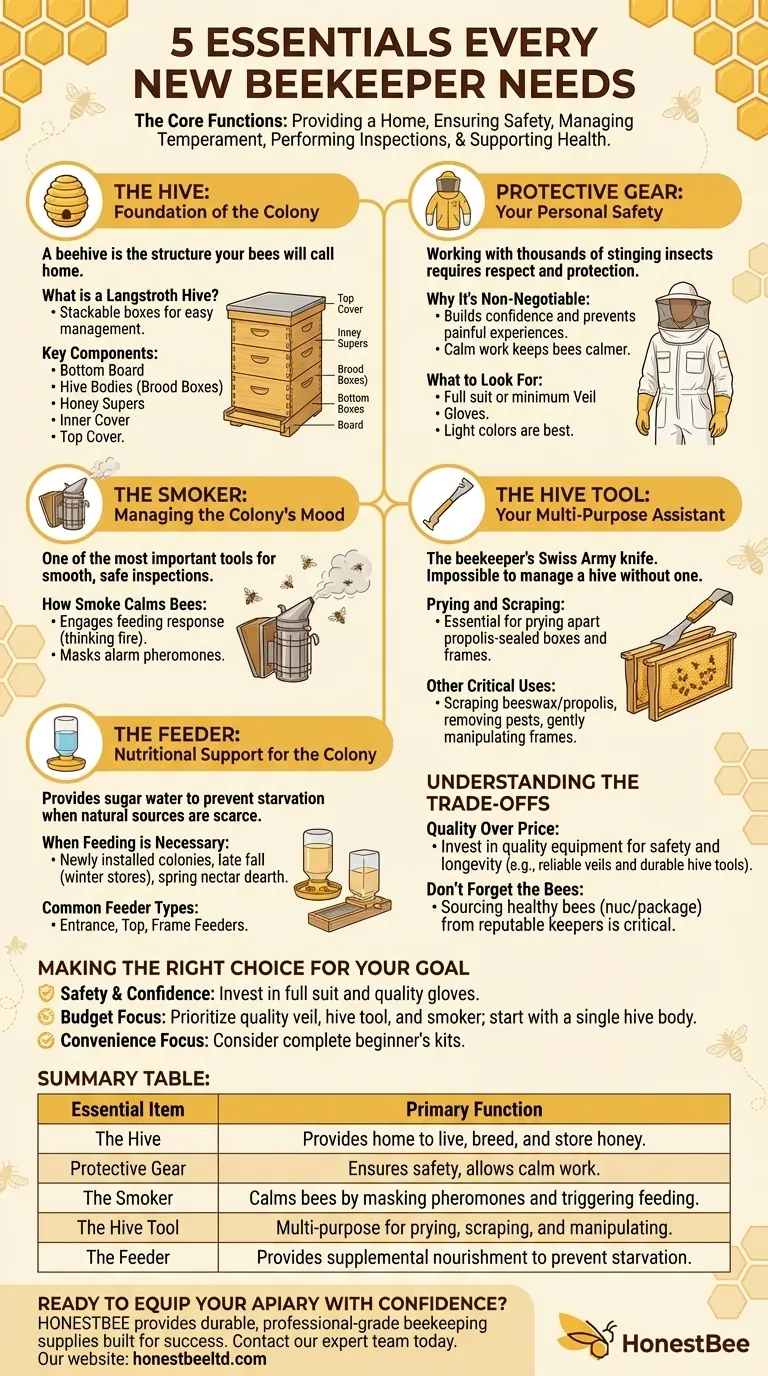To start beekeeping, you need five essential categories of equipment. These include the hive boxes to house the colony, protective gear for your safety, a smoker to calm the bees, a hive tool for inspections, and a feeder to provide nourishment when natural sources are scarce.
The five essential items are more than just a checklist; they represent the core functions of beekeeping: providing a home, ensuring your safety, managing the colony's temperament, performing inspections, and supporting the bees' health.

The Hive: The Foundation of the Colony
A beehive is the structure your bees will call home. Understanding its components is fundamental to managing your colony's growth and health.
What is a Langstroth Hive?
The Langstroth hive is the most common design for modern beekeepers. It consists of a series of stackable boxes, which makes inspections and honey harvesting much more manageable.
Key Components to Understand
The hive is made of several parts. It starts with a bottom board, followed by one or more hive bodies (or "brood boxes") where the queen lays eggs, and then honey supers, which are shallower boxes for honey storage. An inner cover and a top cover complete the structure.
Protective Gear: Your Personal Safety
Working with thousands of stinging insects requires respect and proper protection. High-quality gear builds confidence and prevents painful experiences.
Why It's Non-Negotiable
Even the most gentle hive can become defensive. A good bee suit, veil, and gloves are your first line of defense, allowing you to work calmly and deliberately, which in turn keeps the bees calmer.
What to Look For
A full suit is best for beginners, but at a minimum, you need a veil to protect your face and neck. Gloves are also critical, though some experienced keepers work without them. Always choose light-colored gear, as dark colors can appear threatening to bees.
The Smoker: Managing the Colony's Mood
The bee smoker is one of the most important tools in beekeeping. It doesn't harm the bees but serves a critical purpose in making inspections smoother and safer.
How Smoke Calms Bees
When bees detect smoke, they engage a feeding response, thinking their hive is threatened by fire. They begin to gorge on honey in preparation to potentially abandon the hive.
This consumption makes them physically less able to flex their abdomens to sting. It also masks the alarm pheromone that guard bees release, preventing a colony-wide defensive response.
The Hive Tool: Your Multi-Purpose Assistant
This simple piece of metal is the beekeeper's equivalent of a Swiss Army knife. You will find it impossible to manage a hive without one.
Prying and Scraping
Bees use a sticky substance called propolis to seal every crack and gap in their hive. The hive tool is essential for prying apart hive boxes and frames that have been glued together with this propolis.
Other Critical Uses
The hive tool is also used to scrape away excess beeswax and propolis, remove pests like wax moths, and gently manipulate frames during an inspection.
The Feeder: Nutritional Support for the Colony
A healthy colony can usually feed itself, but there are critical times when they need your help. A feeder allows you to provide sugar water to prevent starvation.
When Feeding is Necessary
You will need to feed a newly installed colony to help them draw out the comb on their new frames. You may also need to feed your bees in late fall if they haven't stored enough honey for winter or during a spring nectar dearth.
Common Feeder Types
Several types exist, including entrance feeders, top feeders, and frame feeders. Each has its own advantages, but all serve the same core purpose of providing supplemental nourishment.
Understanding the Trade-offs
Simply buying the five essentials isn't enough. A common pitfall is misunderstanding the context in which these tools are used.
Quality Over Price
It can be tempting to buy the cheapest gear available. However, a poorly made veil can fail and lead to stings, while a cheap hive tool can bend. Investing in quality equipment from a reputable supplier pays dividends in safety and longevity.
Don't Forget the Bees
Equipment is useless without the main ingredient: the bees. Sourcing a healthy nucleus colony ("nuc") or a package of bees from a local, reputable beekeeper is far more critical to your success than having the fanciest smoker on the market.
Making the Right Choice for Your Goal
As you assemble your initial equipment, let your primary goal guide your purchasing decisions.
- If your primary focus is safety and confidence: Invest in a full, ventilated bee suit and high-quality leather gloves.
- If your primary focus is budget: Prioritize a quality veil, hive tool, and smoker; you can start with a single deep hive body and add more equipment as your colony and budget grow.
- If your primary focus is convenience: Consider purchasing a complete beginner's kit from a well-regarded beekeeping supply company to ensure all components are compatible.
Mastering these five essential tools is the first step toward becoming a confident and successful beekeeper.
Summary Table:
| Essential Item | Primary Function |
|---|---|
| The Hive | Provides a home for the colony to live, breed, and store honey. |
| Protective Gear | Ensures your safety from stings, allowing you to work calmly. |
| The Smoker | Calms bees by masking alarm pheromones and triggering a feeding response. |
| The Hive Tool | A multi-purpose tool for prying apart hive components and scraping propolis. |
| The Feeder | Provides supplemental nourishment to prevent starvation, especially for new colonies. |
Ready to Equip Your Apiary with Confidence?
As a trusted wholesale supplier to commercial apiaries and equipment distributors, HONESTBEE provides durable, professional-grade beekeeping supplies built for success. Whether you're starting your first hive or managing a large-scale operation, our equipment ensures safety, efficiency, and longevity.
Let's discuss your specific needs. Contact our expert team today to get reliable equipment that supports your beekeeping goals.
Visual Guide

Related Products
- HONESTBEE Professional Long Handled Hive Tool with Precision Cutting Blade
- HONESTBEE Advanced Ergonomic Stainless Steel Hive Tool for Beekeeping
- Langstroth Bee Hives Bee Keeping Box for Beginners Beekeeping
- Professional Dual-End Stainless Steel Hive Tool for Beekeeping
- Professional Galvanized Hive Strap with Secure Locking Buckle for Beekeeping
People Also Ask
- What tools are used for cleaning frames? A Beekeeper's Simple 4-Tool Guide
- What are some common uses of a hive tool? Essential Multi-Purpose Tool for Every Beekeeper
- What are the basic tools for beekeeping? Essential Starter Kit for Safe & Successful Hive Management
- What is the hive tool used for? The Essential Multi-Tool for Every Beekeeper
- What is a hive tool and what are its uses? Master Your Hive Inspections with the Essential Beekeeper's Tool



















